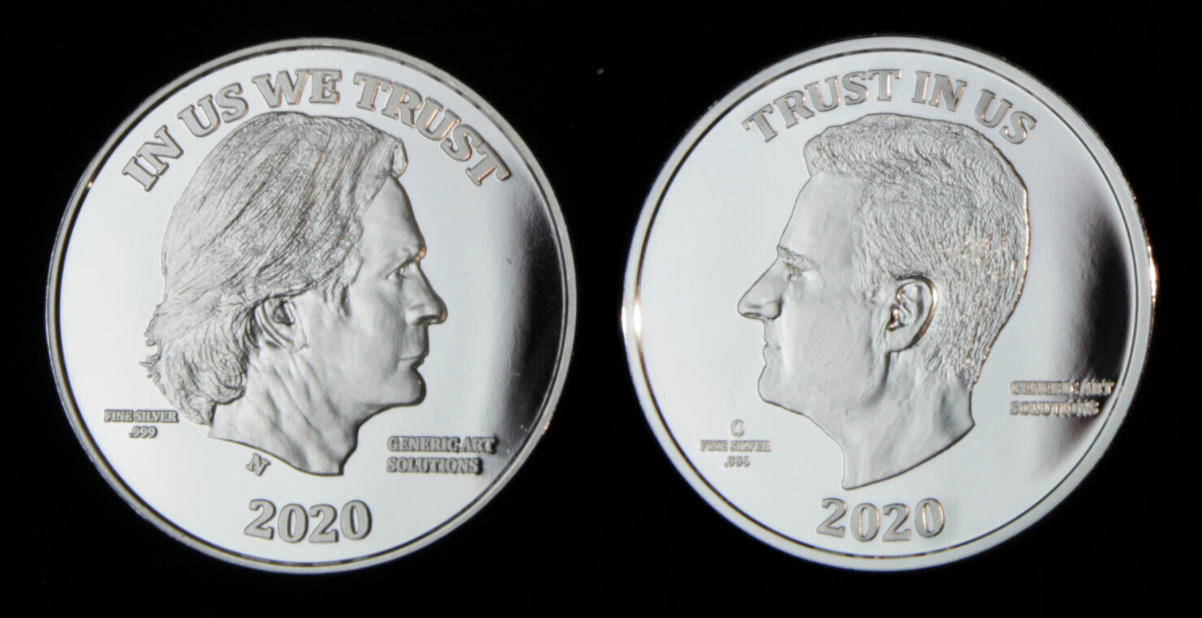Prospect.5's "Face Value" is Right at Home in The Old Mint

A bag of stuffed coins from from “Face Value” on a historic cart on the Old Mint’s collection, by Tony Campbell
The Generic Art Solutions installation uses the space to examine our complicated relationships to money.
[Updated] The Generic Art Solutions’ “Face Value: The Illusions of Power and Money” does the things that made Prospect.1 fun. This Prospect.5 satellite show takes place not in one of the fine art spaces but a small room in the Old U.S. Mint where the historic artifacts on display haven’t changed in decades. In a space dedicated to the history of coin-making, Tony Campbell and Matt Vis present a show that features immediately appreciable objects that seem smarter the longer you think about them. They insinuate their pieces into the display, some so subtly that a casual tourist walking through the space for the first time could assume they were historical geegaws as well. Campbell and Vis’ work infiltrates the Old U.S. Mint’s show in much the same way that money infiltrates almost every part of our lives, and that’s just one of the ways their show resonates.
For the occasion, they’ve put coins at the center of their critique of capitalism, which is its own little in joke because a coin doesn’t buy a thing these days. They built two coin-operated machines for the show, but “Face Value” might be the last place where you could play these games for less than a dollar. They minted their own two-headed coin which is itself a beautiful and beautifully crafted object with Campbell’s silhouette on one side and Vis’ on the other. But in the spirit of play, they’ve stashed it in a display of coins minted in New Orleans. They named the coin “Heads You Lose” because if it were used to flip a coin, the game would be rigged—a reality signaled by the slogans cut into each side of the coin. One reads, “Trust in Us,” while the other side says, “In Us We Trust.” Those with the money and the stature to be on one know whose ideas count in this world, and it’s not you.
“Heads You Love” by Generic Art Solutions, by Tony Campbell
Two digital animations play with the allure of money. One presents a coin spinning on the ground, wobbling as if it’s about to finally end the spiral and fall to rest, but it never does. It’s presented as endlessly vital, while the other shows coins falling to the ground and bouncing, spinning, them ending up flat on the digital ground. In both cases, the coins are gorgeously rendered—unnaturally so, the monetary equivalent of airbrushed photos of models. Campbell and Vis present money as impossibly alluring, so much so that it’s hard to turn away, even when you’ve got all you’re going to get from it.
Campbell and Vis’ work usually plays a similarly complicated game with their personal presence. Here as in other pieces they’ve, they’re all over it, but not in the ways we expect. We don’t get conventionally self-expressive art, but their profiles are everywhere and in another video piece, they imagine their own deaths. When Ryan Scully sings about placing pennies on my eyes, Campbell places their two-headed coins over the eyes of Vis, lying in state. Later in the video, Vis does the same for the prone and lifeless Campbell, dressed for the casket.
The show comes with its own soundtracks. A turntable equipped with headphones plays a gold record—of course—titled Minted, and the songs on it are real, performed—and in some cases, written—by NOCCA students. A working jukebox right inside the doorway into the show features 45s with only songs about money. In a rare moment for this show, the jukebox is free, but even that invites associations and considerations. If they charged people to play these songs, Campbell and Vis would be on the hook for royalties to ASCAP and BMI, so monetary considerations forced certain choices, but the free jukebox also feels like a comp at a casino, where a free thing puts you in the right frame of mind to hang around and spend—and likely lose—more money.
“Easy Coin” stuffed coins by Generic Art Solutions, by Matt Vis
And the two coin-operated machines work in that way. “Easy Coin” is a skill-crane game, where for four quarters, you can try to win a stuffed coin. The coin itself looks like something you’d catch at a Mardi Gras parade or find inside a real skill-crane game, where the context and the desire to win makes you want the object far beyond its actual cost merits. In that way, “Easy Coin” riffs on the act of collecting art. Is a stuffed coin won in a game valuable? Does the relative cheapness of its construction or the fact that anyone can win one affect its value? Campbell and Vis took steps to give the stuffed coins actual worth by putting the plans for how to make your own “Easy Coin” game inside them, along with permission for the holders to make their “Easy Money” machine, but players don’t know that unless they read this piece. The assignment of value is in the player’s head.
Players similarly have more on the line than just a token on “Louisiana Landfall,” the kind of game found in a Chuck E. Cheese, with a moving tray covered with gaming tokens that pushes forward and recedes. Maybe it will push tokens over the edge and into the cup, which will make you a winner, or maybe your token will end up on the pile of tokens that will eventually go to someone else. But the game is not only about tokens. Its uses them and the machine’s moving shelf’s wave-like motion in and out to help which tell Louisiana’s story in two sides. One reads “1803” and “Louisiana Under Native Stewardship,” and it presents a map of the state with the southern border we recognize from maps we’ve known since grade school. The flip side reads “2021” and “Losing One Football Field of Land an Hour since 1985,” accompanied by an erosion-riddled southern border that’s shocking but perhaps still be a little generous.
“Louisiana Landfall” gaming token by Generic Art Solutions, by Alex Rawls
That note of environmental realism feels a little at odds with the voice of “Face Value,” but the game itself keeps the piece on track. The damage to Louisiana’s southern border comes from the oil industry exacting resources from the ground, putting the company’s interests over those of the ecosystem as a whole, and the game works in a similar way. Those who win can pocket their tokens and go—which is tempting because these are themselves little pieces of art, beautifully made, and, hey, they won them!—but if they do, the game really won’t work for those who come after if there aren’t enough tokens to be pushed over the edge. The players are placed on a low stakes level in same position as those in the oil companies who placed profits ahead of the sustainability of a region.
“Face Value” never feels that heavy, not even when at the machine because it’s a game, after all. There’s probably no thought more worth thinking through in contemporary American life than our relationships to money, and “Easy Coin” find ways to subtly get to some thorny concepts. Pieces like their piggy banks, made in their images, and chocolate two-headed coins foreground a central playfulness, and there’s a punk sense of humor in the way Campbell and Vis have put pieces from their show into the Mint’s standing displays. Even that comes with valences though, as they temporarily mess with history and insert themselves into previous timelines, putting their two-headed coins on antique examinination mats, and bags of their stuffed coins on antique carts. Their show’s in a space that tells the history of coins in New Orleans, which temporarily puts Campbell, Vis, and their implication that the game is rigged into the history of money in the city. In the process, their show may have also hit on a fundamental truth.
Updated November 25 a.m.
The skill-crane-like game is called “Easy Coin,” not “Easy Money” as originally written. The text has been changed to reflect this.
Creator of My Spilt Milk and its spin-off Christmas music website and podcast, TwelveSongsOfChristmas.com.









